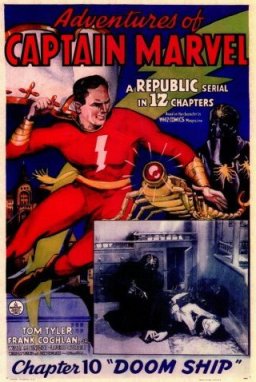
Adventures of Captain Marvel is a 1941 American 12-chapter black-and-white movie serial from Republic Pictures, produced by Hiram S. Brown, Jr., directed by John English and William Witney, that stars Tom Tyler in the title role of Captain Marvel and Frank Coghlan, Jr. as his alter ego, Billy Batson. The serial was adapted from the popular Captain Marvel comic book character, then appearing in the Fawcett Comics publications Whiz Comics and Captain Marvel Adventures. The character is now owned by DC Comics and is known as Shazam.

Radar Men from the Moon is a 1952 Republic Pictures' 12-chapter movie serial, the first Commando Cody serial starring newcomer George Wallace as Cody, Aline Towne as his sidekick Joan Gilbert, and serial veteran Roy Barcroft as the evil Retik, the Ruler of the Moon. The director was Fred C. Brannon, with a screenplay by Ronald Davidson, and special effects by the Lydecker brothers. This serial recycles the flying sequences from Republic's earlier 1949 serial King of the Rocket Men. It was later released by Republic in 1966 as the 100-minute television film Retik the Moon Menace.

Zombies of the Stratosphere is a 1952 colorless Republic Studios serial directed by Fred C. Brannon, with a screenplay by Ronald Davidson, and special effects by Republic's Lydecker brothers. It was intended to be Republic's second serial featuring "new hero" Commando Cody and the third 12-chapter serial featuring the rocket-powered flying jacket and helmet introduced in King of the Rocket Men (1949). Instead, for reasons unknown, the hero was renamed "Larry Martin", who must prevent Martian invaders from using a hydrogen bomb to blow Earth out of its orbit, so that the Martians can move a dying Mars into a much closer orbital position to the Sun. As in Radar Men from the Moon, much of the screen time for each of the dozen chapters is spent on fistfights and car chases between the heroes and a gang of earthly crooks hired by renegade scientist Dr. Harding and his extraterrestrial colleague Marex to steal and stockpile the Atomic supplies needed for construction of the H-bomb.

The Fighting Devil Dogs (1938) is a 12-chapter Republic movie serial starring Lee Powell and Herman Brix, the latter better known by his later stage name, Bruce Bennett. It was directed by William Witney and John English. While not often considered a great serial, as it contains much stock footage and two recap chapters, it is famous for its main villain, the Lightning—the first costumed supervillain. There is some speculation that George Lucas used the Lightning as a template for Darth Vader.
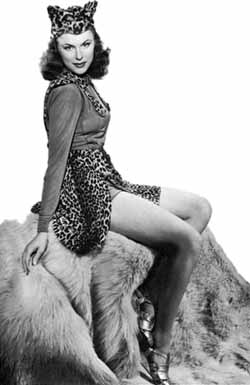
The Tiger Woman (1944) is a 12-chapter film serial by Republic Pictures starring Allan Lane and Linda Stirling. The serial was re-released in 1951 under the title Perils of the Darkest Jungle and, in 1966, it was edited into the 100-minute Century-66 film Jungle Gold.

Jungle Girl is a 1941 15-chapter Republic serial starring Frances Gifford. It was directed by William Witney and John English based on the novel Jungle Girl (1932) by Edgar Rice Burroughs. It was the 22nd of the 66 serials produced by Republic.

King of the Royal Mounted (1940) is a Republic Pictures northern serial based on the King of the Royal Mounted comic strip directed by William Witney and John English.

Darkest Africa (1936) is a Republic movie serial. This was the first serial produced by Republic Pictures and was a loose sequel to a Mascot Pictures serial called The Lost Jungle, also starring Clyde Beatty. Mascot, and other companies, had been taken over in 1935 by Consolidated Film Laboratories and merged to become Republic. Producer Nat Levine was formerly the owner of Mascot Pictures.
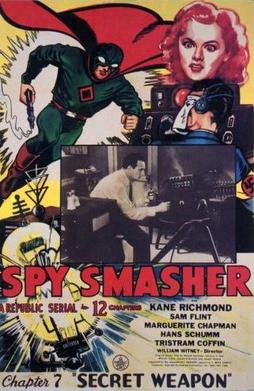
Spy Smasher is a 12-episode 1942 Republic serial film based on the Fawcett Comics character Spy Smasher which is now a part of DC Comics. It was the 25th of the 66 serials produced by Republic. The serial was directed by William Witney with Kane Richmond and Marguerite Chapman as the leads. The serial was Chapman's big break into a career in film and television. Spy Smasher is a very highly regarded serial. In 1966, a television film was made from the serial footage under the title Spy Smasher Returns.
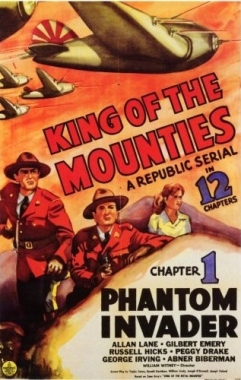
King of the Mounties is a 1942 Republic 12-chapter film serial, directed by William Witney. Allan Lane played Sgt. Dave King of the Mounties, with Peggy Drake as heroine Carol Brent, and Abner Biberman played the villainous Japanese admiral Yamata.
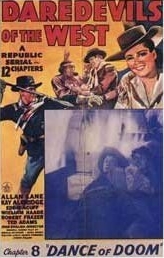
Daredevils of the West is an American Western movie serial consisting of 12 chapters, released by Republic Pictures in 1943 starring Allan Lane and Kay Aldridge. The plot involves a gang of land-grabbers who try to prevent safe passage of the Foster Stage Company through frontier territory. There are similarities of style with other Republic serials released during wartime, such as King of the Mounties and The Masked Marvel.

Secret Service in Darkest Africa is a 1943 Republic serial. It was Republic's thirtieth serial, of the sixty-six produced by the studio.
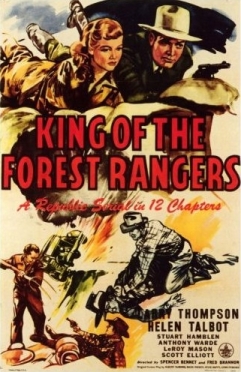
King of the Forest Rangers (1946) is a Republic film serial.
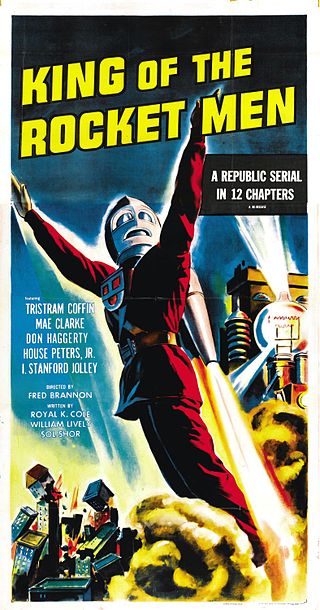
King of the Rocket Men is a 1949 12-chapter movie serial from Republic Pictures, produced by Franklin Adreon, directed Fred C. Brannon, that stars Tristram Coffin, Mae Clarke, Don Haggerty, House Peters, Jr., James Craven, and I. Stanford Jolley.

Don Daredevil Rides Again (1951) is a Republic Movie serial. It makes heavy use of stock footage from Republic's previous Zorro serials. The character of Don Daredevil was created for this serial as the rights to Zorro belonged to Disney by 1951.

Jungle Drums of Africa is a 1953 12-episode American serial film shot in black-and-white. It was an original commissioned screenplay by Ronald Davidson produced by Franklin Adreon and directed by Fred C. Brannon for Republic Pictures. The story is set in Kenya, and involves the efforts of an American uranium processing company's representative and a woman medical missionary, to thwart the efforts of agents of a "foreign power", abetted by a disaffected native witchdoctor, to gain control of a large uranium deposit on lands owned by the latter's tribe. This serial features black American actors in major roles, including that of a college-educated chieftain.

Trader Tom of the China Seas is a 1954 Republic film serial directed by Franklin Adreon and starring Harry Lauter, Aline Towne, Lyle Talbot, Robert Shayne, Fred Graham, and Richard Reeves. In 1966 the serial was edited into Century 66 100-minute television film with the new title Target: Sea of China.

Man with the Steel Whip is a 1954 Republic Western serial film. It uses considerable stock footage from the previous Republic serials "Zorro's Black Whip", "The Painted Stallion" and "Daredevils of the West."

King of the Carnival (1955) is a Republic movie serial that contains a substantial amount of stock footage from the earlier Republic serial Daredevils of the Red Circle. It is the 66th and final serial produced by Republic and is often considered to be among the studio's worst. The plot concerns treasury agents investigating a Cold War counterfeiting operation believed to be connected to a circus.

Captain America is a 1944 Republic black-and-white 15-chapter serial film loosely based on the Timely Comics character Captain America. It was the last Republic serial made about a superhero. It also has the distinction of being the most expensive serial that Republic ever made. It stands as the first theatrical release connected to a Marvel character; the next theatrical release featuring a Marvel hero would not occur for more than 40 years. It was the last live-action rendition of a Marvel character in any medium until Spider-Man appeared in the Spidey Super Stories segment of the children's television series The Electric Company in 1974.














